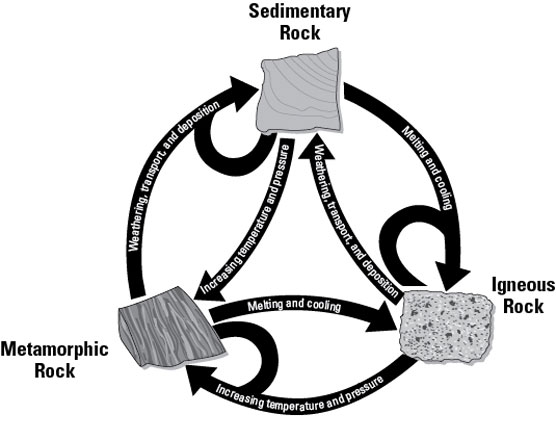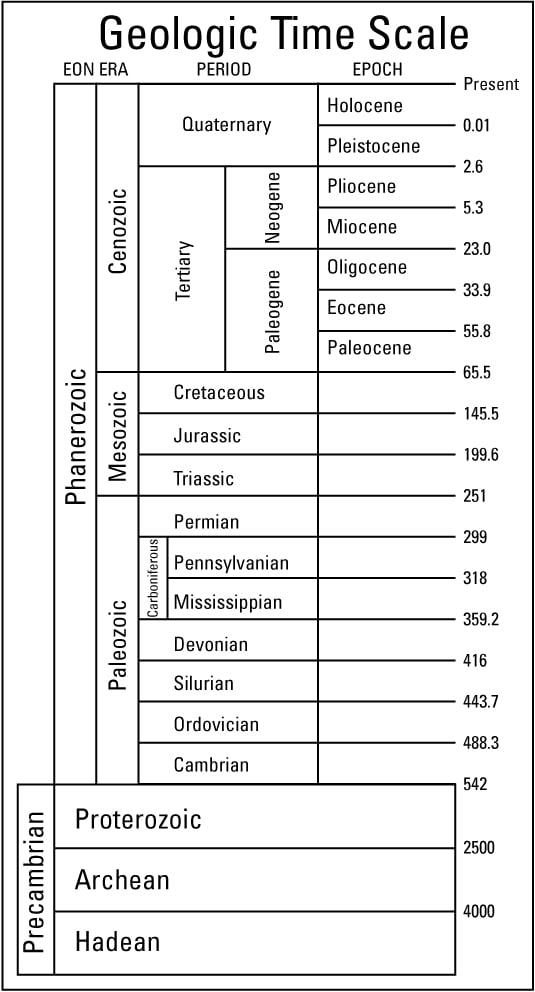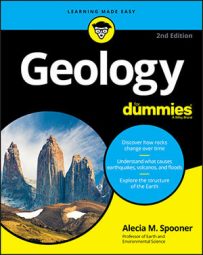The three categories of rocks and the rock cycle
Geologists classify the rocks of earth’s crust in one of three categories — igneous, metamorphic, or sedimentary — based on how the rock was created. Each type of rock has its own unique characteristics:
-
Igneous: Igneous rocks form from the cooling of melted rock (either lava or magma) into solid form. If the cooling occurs underground, the rock is an intrusive, or plutonic, igneous rock. If the cooling occurs on the earth’s surface, the rock is an extrusive or volcanic rock.
Geologists describe different igneous rocks according to their texture and composition.
-
Metamorphic: Metamorphic rocks form when existing rocks are subjected to intense heat and pressure, usually deep below the earth’s surface. These conditions change the original minerals of the rock into new minerals.
Geologists classify metamorphic rocks according to how much they have been changed from the original, or parent, rock. Low-grade metamorphic rocks still appear very similar to the parent rock, while high-grade metamorphic rocks have been changed so much that they look very different from the parent rock.
-
Sedimentary: Sedimentary rocks are either detrital or chemical. Detrital rocks are formed by the compaction of separate particles, or sediments, into a rock. The particles are pieces of a different, pre-existing rock that have been weathered and transported by wind, water, ice, or gravity. Chemical sedimentary rocks form from minerals that have been dissolved in water and precipitate out, forming a solid rock.
Geologists describe sedimentary rocks according to the size and shape of the particles in them or their mineral composition (in the case of chemical sedimentary rocks).
The rocks of earth’s crust are constantly being recycled and changed into new forms through geologic processes. This continual transformation of rocks from one type to another is called the rock cycle. Through processes such as weathering, heating, melting, cooling, and compaction, any one rock type can be changed into a different rock type as its chemical composition and physical characteristics are transformed.

How crustal plates move: plate tectonics
Plate tectonics is the unifying theory of geology. This theory explains how crustal plates move around the surface of the earth, and it allows geologists to find explanations for geologic events such as earthquakes and volcanoes, as well as the many other processes that form, transform, and destroy rocks.
The crust of the earth is separated into ten major plates and a few smaller ones. These plates interact with each other along their edges as they shift position on the earth’s surface. The motion of crustal plates is described as the relative motion between two plates where they touch; this motion fits into one of three categories:
-
Convergent: Where two plates are moving toward one another, they form a convergent plate boundary.
-
Divergent: Where two plates are moving away from each other, they form a divergent plate boundary.
-
Transform: Where two plates are moving alongside one another, they form a transform boundary.
Early in the twentieth century, a scientist named Alfred Wegener proposed that the continents had once been attached to one another, forming a single large land mass or supercontinent, and had then drifted apart.
While he had some good evidence to support his hypothesis, it wasn’t until after World War I that scientists made progress in developing a solid theory of plate movement. The use of submarines in WWI prompted extensive mapping and study of the ocean floor. Through these studies, scientists discovered that the rocks on the floor of the Atlantic Ocean were of different ages — and the ages could be traced from oldest (nearest the continents) to youngest (along a ridge down the middle of the ocean). What they had discovered was that new ocean floor is created along a divergent plate boundary in the middle of the Atlantic Ocean.
This finding in the Atlantic Ocean provided new energy to supporters of Wegener’s earlier hypothesis and led the way to decades of intensive undersea geological research. Only fairly recently — in the 1960s — did researchers have enough evidence to propose an explanation for how crustal plates move around the earth’s surface and interact with one another: the theory of plate tectonics.
The geologic timescale
Geologists organize the 4.6 billion years of earth’s history into sections based on important changes seen in the geologic record. The largest intervals are eons, with each eon composed of many millions of years. Within the eons are eras, which begin and end with dramatic changes in the types of plants and animals living on earth. Within each era are multiple periods, and within each period are multiple shorter epochs.
Because the intervals of the geologic timescale are based on observed changes in fossilized remains on life on earth, the span of time within each interval varies. While the divisions may be confusing at first, learning about the events in earth’s history goes hand-in-hand with learning the geologic timescale, shown below. (The numbers on the right side reflect the absolute age, expressed in millions of years ago, of the earth at each interval.)
The geologic timescale is continually being revised by new research and more accurate dating methods. When changes are proposed, the International Commission on Stratigraphy determines if an official change to the timescale should be made. For the most recent version, check out the Commission’s website.


